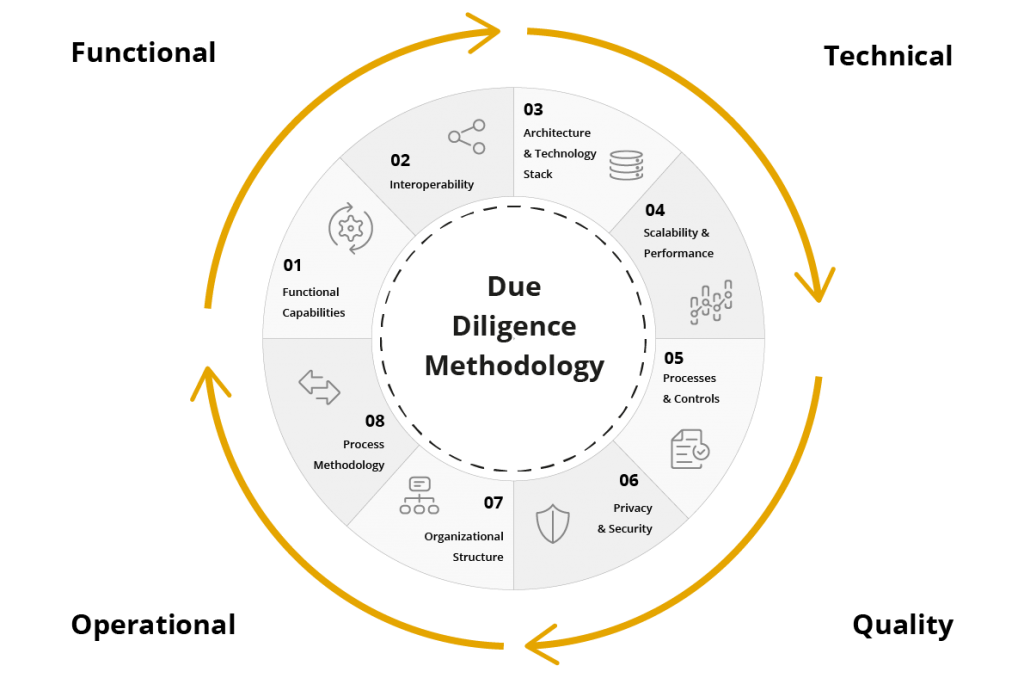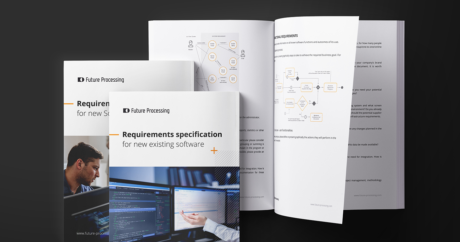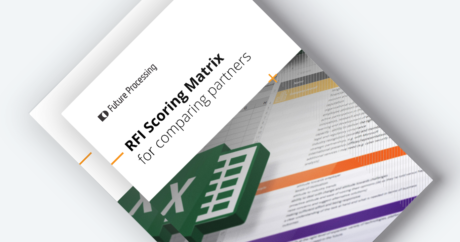In the case of many transactions, especially those involving locating large sums in IT products, technical due diligence is an obligatory part of the investment process. To make an informed decision, more and more companies conduct a detailed analysis of a running project, whose main aim is to check whether its assumptions and the resulting products will meet the expectations of stakeholders.
We prepared a dedicated Software Development Due Diligence Checklist for IT investments to guide you through the process effortlessly.
Due Diligence types
The main objective of due diligence analysis is to assess the risk associated with the planned or ongoing investment. Each study is of an individual nature, depending on the specifics of the audited entity. What’s crucial here, is that due diligence is always carried out by a team of specialists in a given field (i.e. IT experts), which provides you with a deep insight into a given area of the company’s operations, creating a complete, accurate, and highly detailed picture of its overall condition.
Sometimes, to examine a chosen area of the company’s operations more broadly or to diagnose a problem to which the investor pays particular attention, additional studies can be conducted. Therefore, the scope of the due diligence procedure is always tailored to the specific case.
Due diligence for IT – invest in proven solutions
The software development life cycle consists of several phases, including the scope of the project, its subsequent maintenance, and further development. Regardless of whether the project is carried out with the use of traditional or agile management methods, the finished product (i.e., bespoke software), is created as a result of the implementation of certain assumptions defined in the initial phase.
Those assumptions, gathered in software requirements specification (and followed by the other types of IT project documentation), are accepted by the client and the development team, then adopted in the form of a project plan or a product backlog. They are implemented in the pre-planned order in further iterations of the software.
The aim of the technical due diligence analysis is not only to check what functionalities the software should have but also to assess whether, as a result of the planned project work, it will meet customer requirements and legal standards. It will also provide you with the information if the project is justified from an economic perspective.

Consequently, software due diligence allows assessing the current status of the project progress, as well as to indicate its potential and identify all disadvantages and threats related to a current situation of given application development. In practice, it is a simulation of profits and losses, for which each investor should decide if wishes to keep developing the software.
Due diligence should not be confused with an audit, which usually covers one area of control and results from the internal demand of the company. In fact, the software analysis can be commissioned by both external or internal party, giving the software development company the chance to eliminate potential threats that could discourage the investor, or showing the investor a true picture of the IT development progress.
It is also estimated that companies that perform due diligence on their long-term software development processes have better chances of getting higher and positive returns from their investments.
Software due diligence – a valid tool for risk management
The main purpose of the technical due diligence analysis is to gather comprehensive information necessary to assess the progress of software development and identify factors having a significant impact on it. Thus, software due diligence requires proper organisation and deep expertise of the analysts so that it can work best for the benefit of the parties to the transaction.
The analysis of IT projects using the due diligence method should refer to the risk analysis in the whole project life cycle. It prevents the investor from a situation when the organisation will develop a project whose initial assumptions are inappropriate, and thus the finished product will not meet the expectations of its recipients, generating additional costs.
In IT projects the most typical areas taken into account during the software due diligence analysis are:
- the team of people involved in the implementation of a given project, including the knowledge, skills and experience of team members, the way they work or manage the workflow,
- the technology used during the project, including its innovation, quality of code, competitive advantage and intellectual property rights,
- market and marketing potential of the product developed within a given project, determined by such factors as the size and prospects of the market, strength of competitors, ability to reach a market niche,
- legal conditions, including protection of intellectual property rights, security and stability of the software,
- financial factors, in particular the rationality and correctness of financial estimates concerning the valuation of the project and its profitability.

It’s worth to mention that due diligence takes into account the risks occurring in the initial phase of the software development life cycle, related to e.g. incorrect identification of the client’s needs, application of the wrong technology or incorrect definition of the software’s usability and functionality. To do so, simply click here and download our Software Development Due Diligence Checklist for IT investments, which will help you perform an initial Due Diligence audit on your software.
What’s interesting, more and more investors seem to use the due diligence to choose the most suitable outsourcing partner, as the method allows to assess the chance of concluding a favourable agreement with a business partner (and compare its stability with the competition).
Due diligence: update your existing product
Due diligence can be also used to optimise the company’s operations. The analysis is highly flexible, including the combination of unique conditions for each enterprise such as the characteristics and specifics of the company’s operations, its structure, size of revenues, as well as the number of employees.
The software due diligence may also be successfully used to adapt the existing software or system to new conditions identified as its result. They may refer to the specificity of the market (e.g. as a result of the emergence of new customer needs), the demand for a specific type of technology (e.g. concerning solutions introduced by other companies from the industry), as well as legal requirements. The information obtained from the analysis allows for optimising the scope of the project and better planning of sub-projects, taking into account key risk factors.
How to perform due diligence of IT projects?
It is difficult to develop one universal model of software project due diligence because each study should be individualised, adjusted to the specificity of a given project and the market to which the software is directed.
However, it is possible to indicate some basic phases of the study:
- Preparing a project for a study requires to determine the purpose of the analysis, and therefore the information to be obtained from it. Keep in mind, that the way it will be formulated will determine the scope of the study.
- Preliminary research focuses on the project itself, including its assumptions and requirements for the product (included i.e., in its documentation). During the research, it is also necessary to check what is the level of stability and security of IT solutions developed within the project. The assessment of these aspects should be accompanied by a computer hardware inventory, as well as an analysis of qualifications and competences of project team members.
- In-depth research, in turn, concerns the potential of the product, the possibility of its commercialisation, as well as the provision of support for customers who will use it. At this stage, not only the profitability of the project is assessed, but also its benchmark (e.g. by comparison with the products of competitors).
Once the basis of the analysis is carried out, a report should be prepared, which will contain the conclusions of the study, as well as information on the identified risks in the project. The report should also present recommendations for further project implementation. Due to its scope, this type of analysis is useful during the implementation of long and complex projects, in which the product is subject to numerous modifications.
Rely on experience
Software due diligence is a complex, time-consuming and highly competent procedure, consisting of several essential stages. At each of them, the investor learns the answers to further important questions about products he has taken to his business target. Therefore, it is practically impossible to carry out due diligence by yourself. For maximum objectivity, we highly recommend you seek support from an external partner.
The first step is to make all data necessary to examine its condition available by the company’s authorities. It is essential to use professional research companies whose staff have been trained and competent to use confidential data. Plus, to ensure transparency and reliability, it’s best to involve people who have no connection with either side. Outsourcing may be an interesting option here as it gives maximum impartiality.
Most often the research team consists of experts from various fields, which ensures a professional approach to the matter – if you need to hire an experienced IT specialist to support your due diligence team, contact us right away!
Good practices of cooperation with external experts during IT due diligence
- In order to protect against data leakage, it is necessary to conclude an agreement with the company to carry out the inspection. It should be in written form and contain a statement on the use of confidential information solely for the audit.
- It is important not to hinder the inspection experts and not to block access to necessary documents.
Benefits of applying due diligence in projects
As we’ve mentioned before, due diligence analysis serves the purpose of an in-depth assessment of the software development project, allowing verifying whether it meets the requirements set by different stakeholder groups, and in particular by investors. The analysis examines all the details of the project to obtain detailed information as the results.
Among the most important benefits resulting from the application of due diligence in IT projects can be mentioned:
- constant monitoring of critical success factors of projects,
- systematic risk measurement in the project,
- focus on critical assumptions, important both from the perspective of project implementation and its usefulness for the client,
optimisation of the project planning processes and its phases.
Due diligence is supposed to give the investor an answer to whether it is worth taking a risk and concluding a transaction or looking for the more qualified business entity to cooperate with. It is also used to assess the profitability of the project implementation as well as the risks associated with the process. It helps to identify potential barriers that exist on the market and to identify market segments within which it is possible to commercialise software or help to choose the most appropriate business model for software distribution.
What is extremely important, the analysis is supposed to provide reliable and independent information to both parties. It is a good idea to hire an independent, external company to conduct such an analysis. Thanks to this, both the buyer and the seller have the opportunity to assess the situation and make the right decision. And as a good starting point, we encourage you to use our free Software Development Due Diligence Checklist for IT investments.


